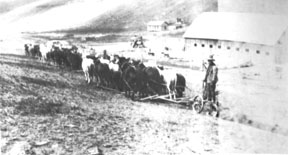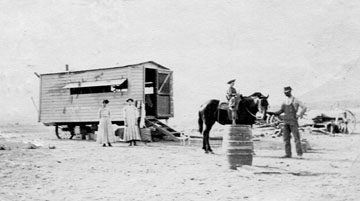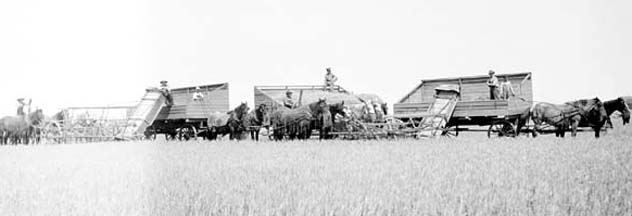
Dryland Wheat Farming, 1910-30
Very little water. Lots of sun. Very few motorized vehicles but lots of horses. The McCutchen boys all took out homesteads in the same area so they could help each other and cut down on the number of people they needed to hire. Nevertheless, they were isolated and the women sometimes didn't see other women for long periods at a time.
 |
In the spring, there's the plowing. In this photo, there are 3 teams pulling plows with about 5 blades per team. Note the extensive farm buildings in the background. The man is George. |
Smoothing out the land and seeding follows. My mother told a story about a magpie that my father found while he was preparing the land. See Maggie for this story. It is a cute story, but more than that, it is about life during these times.
In late summer and early fall, there is the harvesting. This is a busy time on the ranch. Women gather at whatever ranch is using the combine and cook big meals for all the brothers and other helpers.
 |
Sometimes, they'd bring a cookshack to where the harvesting was being done. Cap is riding a horse held by his father, Bill. His mother, Clyde, and another woman watches. |
Sometimes the combine was rented, with or without a crew. Sometimes it was owned. The McCutchen brothers owned theirs as a group and shared it between their 4 or 5 ranches. Time is important. Not only does the rancher have the combine for only a short time, it is also important to get the wheat processed before it rains. Rain is not common but not at all unusual and if it does rain, the wheat may be spoiled.
 |
At first, the brothers used the push header shown here
(the paddle like vehicle to the right, in front of the team. This cut
and collected the wheat which was then brought to a stationary threasher.
Note the Model T to the left, one of the first motorized vehicles the
brothers had. Even years later, George continued to prefer horse powered
farm vehicles although they had cars early on.
|
Although this is not a McCutchen photo, it shows the operation in full perspective:
 |
| The headers cut and pick up the wheat, and send it up the shoot and into the wagon. Then the wagon carts it to the stationary thresher. (Photo Source) |
Sometimes, the wheat was bundled and left to be picked up with cranes and hauled to the thresher, as shown in the photo to the left, below. The photo to the right shows the stationary thresher the brothers used at first. I'm not sure what the sail like thing is on the thresher. Notice the smoke coming out of the vehicle to the left. Again, I don't know what this is. The straw coming out onto the pile was used for bedding for the animals.
 |
 |
Later, the brothers
got a mobile combine that cut the grain and crushed it to separate the wheat
from the chaff. Since this was a very expensive piece of machinery, they shared
it between them. It took a large crew to operate,with a teamster, levelers who
worked the racks and kept the separator level, baggers and sewers. The women
were kept busy in the kitchen cooking large meals for the crews. As the children
grew old enough to help there were jobs as waterboys and cooks-helpers for them
too. The brothers would gather at a ranch, harvest the wheat there, then move
on to the next brother's ranch and repeat the process. The combine blew the
chaff out onto the ground behind it, but the wheat was stored and empited into
sacks which were then sewn shut, stored in a shed and, when harvest was done,
hauled to town to be sold. Click
here for a good description of dryland farming equipment and its operation.
 |
For a good clear photo go to combine. (different photo) Many of the horses here, or their parents, came originally from the home place in Yacolt. JM was always a horse lover and raised great horses. |